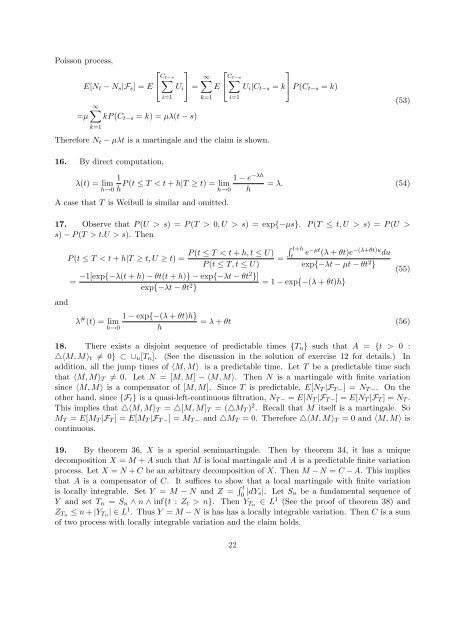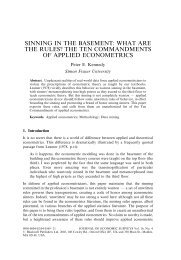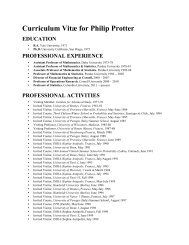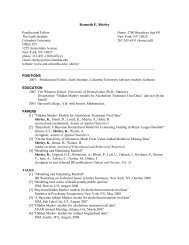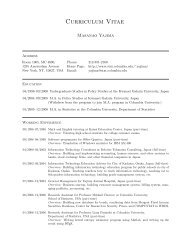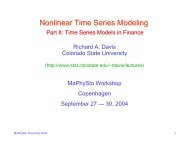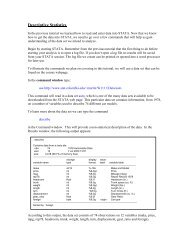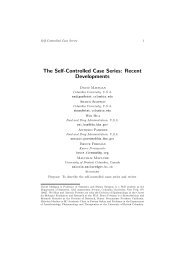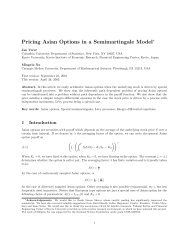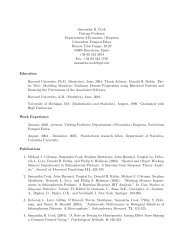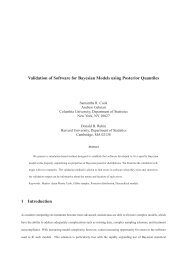Solution to selected problems.
Solution to selected problems.
Solution to selected problems.
You also want an ePaper? Increase the reach of your titles
YUMPU automatically turns print PDFs into web optimized ePapers that Google loves.
Poisson process,<br />
⎡<br />
C∑<br />
t−s<br />
E[N t − N s |F s ] = E ⎣<br />
=µ<br />
i=1<br />
U i<br />
⎤<br />
⎦ =<br />
∞∑<br />
kP (C t−s = k) = µλ(t − s)<br />
k=1<br />
⎡<br />
⎤<br />
C ∞∑ ∑ t−s<br />
E ⎣ U i |C t−s = k⎦ P (C t−s = k)<br />
k=1<br />
Therefore N t − µλt is a martingale and the claim is shown.<br />
i=1<br />
(53)<br />
16. By direct computation,<br />
1<br />
1 − e −λh<br />
λ(t) = lim P (t ≤ T < t + h|T ≥ t) = lim<br />
h→0 h h→0 h<br />
A case that T is Weibull is similar and omitted.<br />
= λ. (54)<br />
17. Observe that P (U > s) = P (T > 0, U > s) = exp{−µs}. P (T ≤ t, U > s) = P (U ><br />
s) − P (T > t.U > s). Then<br />
∫ t+h<br />
P (t ≤ T < t + h, t ≤ U) t<br />
e −µt (λ + θt)e −(λ+θt)u du<br />
P (t ≤ T < t + h|T ≥ t, U ≥ t) = =<br />
P (t ≤ T, t ≤ U)<br />
exp{−λt − µt − θt 2 }<br />
and<br />
= −1[exp{−λ(t + h) − θt(t + h)} − exp{−λt − θt2 }]<br />
exp{−λt − θt 2 }<br />
= 1 − exp{−(λ + θt)h}<br />
λ # 1 − exp{−(λ + θt)h}<br />
(t) = lim<br />
= λ + θt (56)<br />
h→0 h<br />
18. There exists a disjoint sequence of predictable times {T n } such that A = {t > 0 :<br />
△〈M, M〉 t ≠ 0} ⊂ ∪ n [T n ]. (See the discussion in the solution of exercise 12 for details.) In<br />
addition, all the jump times of 〈M, M〉· is a predictable time. Let T be a predictable time such<br />
that 〈M, M〉 T ≠ 0. Let N = [M, M] − 〈M, M〉. Then N is a martingale with finite variation<br />
since 〈M, M〉 is a compensa<strong>to</strong>r of [M, M]. Since T is predictable, E[N T |F T − ] = N T − . On the<br />
other hand, since {F t } is a quasi-left-continuous filtration, N T − = E[N T |F T − ] = E[N T |F T ] = N T .<br />
This implies that △〈M, M〉 T = △[M, M] T = (△M T ) 2 . Recall that M itself is a martingale. So<br />
M T = E[M T |F T ] = E[M T |F T − ] = M T − and △M T = 0. Therefore △〈M, M〉 T = 0 and 〈M, M〉 is<br />
continuous.<br />
19. By theorem 36, X is a special semimartingale. Then by theorem 34, it has a unique<br />
decomposition X = M + A such that M is local martingale and A is a predictable finite variation<br />
process. Let X = N + C be an arbitrary decomposition of X. Then M − N = C − A. This implies<br />
that A is a compensa<strong>to</strong>r of C. It suffices <strong>to</strong> show that a local martingale with finite variation<br />
is locally integrable. Set Y = M − N and Z = ∫ t<br />
0 |dY s|. Let S n be a fundamental sequence of<br />
Y and set T n = S n ∧ n ∧ inf{t : Z t > n}. Then Y Tn ∈ L 1 (See the proof of theorem 38) and<br />
Z Tn ≤ n + |Y Tn | ∈ L 1 . Thus Y = M − N is has has a locally integrable variation. Then C is a sum<br />
of two process with locally integrable variation and the claim holds.<br />
22<br />
(55)


